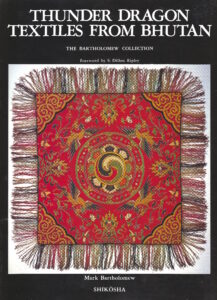The concept and mission of the GreenHeart Foundation started in 1976 with a long and colorful journey of stories of culture, arts, travels, spirituality, politics, business, love, family, nature, and humanitarian pursuits.
Our Founder
Our founder MarkO Bartholomew is a cultural anthropologist who was the first to document, Promote and Preserve the unique culture and textile arts of Bhutan.
Between 1976 and 1982 he collected hundreds of Bhutanese textile treasures from Northeast India and Nepal, through barter with the Bhutanese Royal Families, high-ranking members of the Royal Government of Bhutan, and top religious leaders, such as Rimpoches of Buddhism in Bhutan. This was a time when the awareness of Bhutan and its intricate textiles was completely unknown to art intuitions and scholars around the world.
His travel and research on the connection between culture and symbols have spanned 40 years, leading him from Bhutan, to the Yucatan, and Lan Chang (Laos). While in Laos, he officially established the GreenHeart Foundation to help the women and girls who make amazingly intricate textiles and to offer them a way to better support themselves, their families, and their communities.

MarkO Bartholomew is the published author of the first definitive book on Bhutan Textile Art and Culture ‘Thunder Dragon Textiles from Bhutan,’ Shikosha (Publisher), Kyoto, Japan, 1985, in both English and Japanese. This was the first major publication in the world highlighting Bhutanese culture and textile art heritage.
The Bartholomew Family Collection
The GreenHeart Foundation is the proud custodian and caretaker of the world’s largest private collection of sacred traditional Bhutanese antique textile art. For nearly 50 years, this Buddhist art heritage collection has been stored away and never completely revealed. The Collection consists primarily of antique Buddhist textiles and other sacred religious artifacts from Bhutan totaling over 300 pieces.
The GreenHeart Foundation is developing the means required to Relocate, Inventory, Conserve, and Exhibit (R.I.C.E) the Bartholomew Collection. Our R.I.C.E campaign will create world awareness about these sacred textile relics, and inform future generations about the importance of traditional textile art heritage.
Unique Attributes of Bhutan Textile Art
Two of the most significant one-of-a-kind attributes of Bhutanese weaving is incorporating an extremely rare complex weaving style of single-faced supplementary weft brocade technique called Thima. No other weaving culture in history has ever utilized this technique. It closely resembles chain embroidery stitching. In contrast to embroidery, Thima is executed directly on the loom while weaving. The second unique technique is supplementary warp brocade.
Bhutanese textiles incorporate an extensive usage of symbols. Compared to all other textile cultures, Bhutan uses a multitude of symbols with direct meaning and correlation to nature (e.g., the sun, water, butterflies, and numerous religious artifacts).
While they are weaving, women in small villages traditionally can be heard singing songs that correlate to a specific symbol or part of the textile that they are currently creating.
